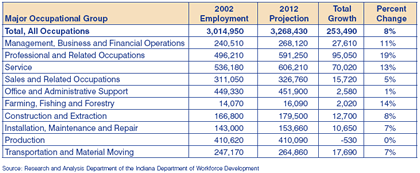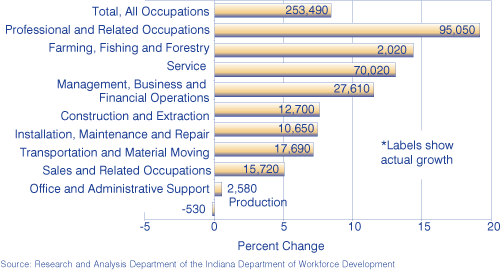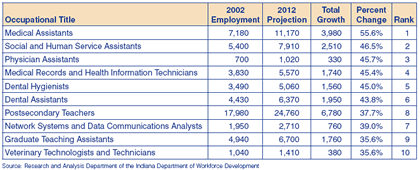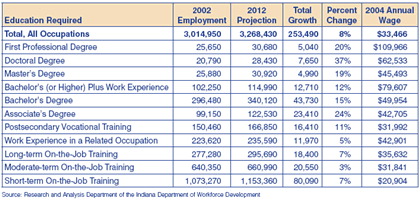Indiana's Occupational Employment Outlook to 2012
Total Growth
Indiana's employment is expected to grow by 253,490 jobs between 2002 and 2012, according to the latest projections from Indiana's Department of Workforce Development. The increase is a little more than 8 percent for the period, well below the nearly 15 percent increase expected for the United States. However, this figure is on par with Illinois, Ohio and Michigan—our neighboring states with similarly heavy employment concentrations in manufacturing.
Major Occupational Groups
The fastest growing major occupational groups are professional and related occupations (19 percent growth), service occupations (13 percent), farming, fishing and forestry occupations (14 percent) and management, business and financial operations occupations (11 percent). Of those, 65 percent of the total growth for the state will come from professional and service occupations, growing by 95,050 jobs and 70,020 jobs, respectively.
Production occupations are expected to show a slight loss, while office and administrative occupations and sales and related occupations will grow only slightly. The remaining groups (construction and extraction, installation, maintenance and repair occupations, and transportation and material moving occupations) will all grow at about the state average (see Table 1 and Figure 1).
Table 1: Projected Growth for Major Occupational Groups
Figure 1: Percent Change in Employment by Major Occupational Group, 2002 to 2012
Industry Growth Impacts Occupations
Indiana's occupational projections are created by first projecting industry employment, then applying staffing patterns and occupational change factors (essentially accounting for changes in occupational needs due to technological advancement) to these industry projections. Therefore, occupational growth is very much a function of individual industry growth. Not surprisingly, occupations that are concentrated in fast-growing industries will grow the fastest, and occupations that are concentrated in slow-growing or declining industries will show little to no growth. Since manufacturing industries have declined over the past decade and are projected to decline through 2012, the impact is felt most heavily in production occupations. Indiana's employment in manufacturing has nearly twice the concentration as the nation (20 percent for Indiana's 2002 employment, 10.6 percent for the United States), which in large part explains the slower growth expectation for the state compared to the nation.
In contrast, professional occupations are concentrated in fast-growing industries, such as health services. Nearly half of health services employment is composed of professional occupations. Ambulatory health services is expected to grow by more than 30 percent. The heavy concentration of professionals in this type of growing industry explains why professional occupations are projected to grow the fastest and provide the greatest number of new jobs.
Detailed Occupations
The dominant major occupational group in terms of percent change is professional and related occupations. Table 2 lists the 10 fastest growing detailed occupations that had an employment level of at least 100 in 2002. Seven of the 10 occupations are a part of the professional group, while the others were from either the management or services group. While not on the “top 10” list, it should be noted that the detailed occupation that is expected to provide the greatest number of new jobs over the 10-year period is registered nurses—growing at 25 percent (11,740 jobs).
Table 2: Top Ten Detailed Occupations by Growth Rate
Education and Wages
Indiana's presentation of occupational projections includes a display of occupations along with the most common educational attainment required and the average wages earned for each occupation. It is clear that most of the fastest growing occupations also require the greater education and are the highest paying jobs (see Table 3). All of the educational attainment groups requiring a degree have an average annual wage of over $42,000, and jobs are expected to grow at double-digit rates. All jobs that require no post-secondary education are expected to grow at a rate below 10 percent. Occupations requiring only short-term on-the-job training pay an average of only $20,904—less than half of the lowest paying group requiring at least an associate's degree. Once again, it appears that education pays and provides the greatest opportunities. (The exception would seem to be in occupations that require a master's degree, as the average wage for that group of occupations is less than those requiring a bachelor's degree. Nearly half of those occupations are in community and social services occupations, such as clergy and rehabilitation counselors—low-paying occupations despite the high level of education required. Were these occupations removed from the group, the average wage expectation for a master's would exceed $52,000.)
Table 3: Growth in Jobs by Educational Attainment Required
Access to the complete 2002–2012 occupational projections for Indiana can be found at www.hoosierdata.in.gov. The projections tables include data for each detailed occupation within its major group and by educational requirements. Also included are tables with hourly and annual wages, rankings according to growth percentage, numeric growth and by total job openings due to growth and replacement needs. In addition to the projections for the state as a whole, projections are also available for each of Indiana's economic growth regions.
Source
All projections data produced by the Research and Analysis Department, Advanced Economic and Market Analysis Group, Indiana Department of Workforce Development.
Jon Wright, Labor Market Analyst
Research and Analysis Department,
Advanced Economic and Market Analysis Group, Indiana Department of Workforce
Development




